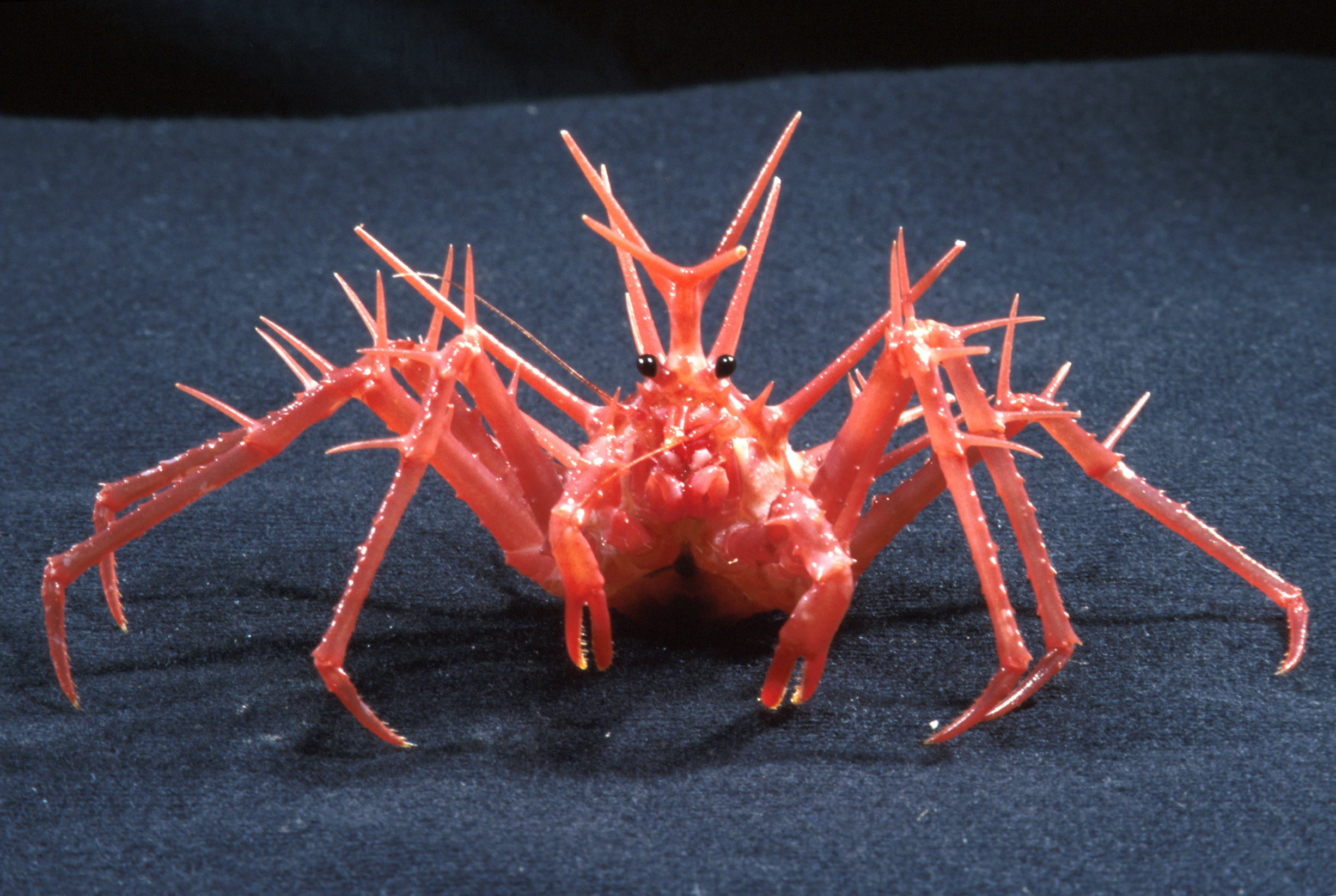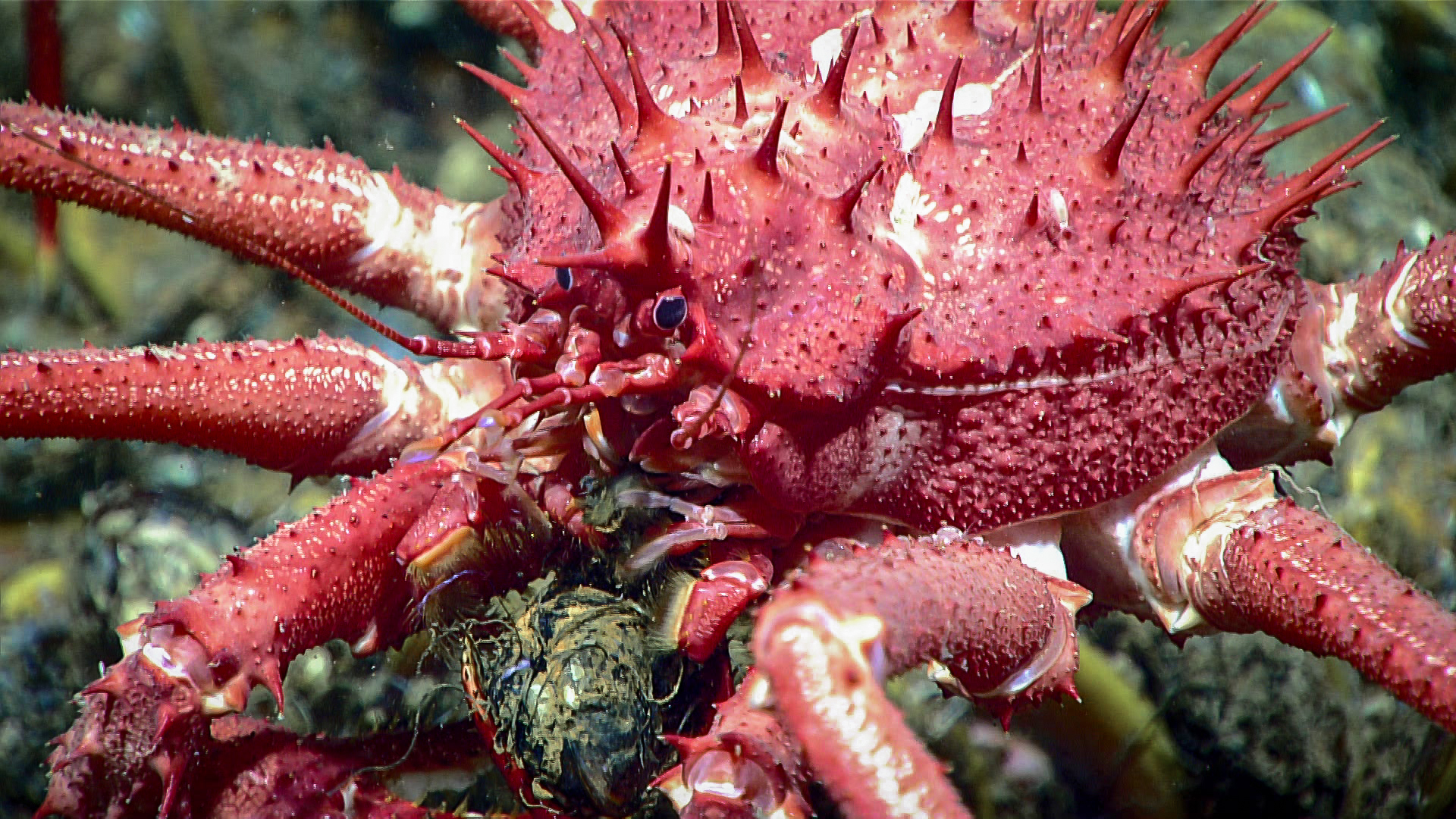왕게과
"오늘의AI위키"의 AI를 통해 더욱 풍부하고 폭넓은 지식 경험을 누리세요.
1. 개요
왕게과는 십각목 집게하목에 속하는 갑각류로, 과거에는 털게상과로 분류되었으나 현재는 집게하목에 포함된다. 털게아과와 왕게아과로 나뉘며, 15개의 속을 포함한다. 왕게는 겉모습이 게와 유사하지만, 보행 다리 수, 복부의 비대칭성, 제2촉각 모양 등에서 차이를 보인다. 전 세계의 다양한 해역에 분포하며, 특히 극지방과 심해에서 발견된다. 상업적으로 중요한 어종으로, 붉은대게와 푸른대게 등이 어획되지만 남획으로 인해 개체 수가 감소하여 어업이 제한되기도 한다.
더 읽어볼만한 페이지
- 왕게과 - 왕게속
왕게속은 십각목에 속하는 게의 한 속으로, 캘리포니아 왕게, 붉은 왕게, 푸른 왕게 등 여러 종을 포함하며 북태평양, 베링해 등지에 분포한다. - 왕게과 - 청색왕게
청색왕게는 북쪽 차가운 해역에 서식하는 킹크랩의 일종으로, 갑폭 15cm까지 자라고 푸른빛 보라색 갑각을 가지며 식용으로 어획되지만 개체 수 감소로 어업이 제한적으로 이루어지고 있다. - 식용 갑각류 - 바닷가재
바닷가재는 집게발을 가진 바닷가재과의 갑각류로, 단단한 외골격, 푸른색 피, 긴 수명, 다양한 해저 서식지, 잡식성 특징을 가지며 식용으로 활용되지만 종교적으로 금기시되기도 하고 백악기까지 거슬러 올라가는 54종이 알려져 있다. - 식용 갑각류 - 대게
대게는 북서대서양과 북태평양의 차가운 해역에 서식하는 암적색의 십각목 홍게과 게로, 겨울철 별미로 인기가 높지만 과도한 어획과 기후변화로 개체 수 감소 문제가 심각하며, 수컷과 암컷에 따라 다양한 지역 명칭으로 브랜드화되어 판매된다.
| 왕게과 - [생물]에 관한 문서 | |
|---|---|
| 기본 정보 | |
 | |
| 분류 정보 | |
| 상위 분류군 | 타라바가니상과 |
| 학명 | Lithodidae |
| 명명자 | Samouelle, 1819 |
| 하위 분류군 | |
| 하위 과 | Hapalogastrinae Brandt, 1850 Lithodinae Samouelle, 1819 |
| 속 | Acantholithodes Holmes, 1895 Cryptolithodes Brandt, 1848 Dermaturus Brandt, 1850 Echidnocerus White, 1842 Glyptolithodes Faxon, 1895 Hapalogaster Brandt, 1850 Lithodes Latreille, 1806 Neolithodes A. Milne-Edwards & Bouvier, 1894 Oedignathus Benedict, 1895 Paralithodes Brandt, 1848 Paralomis White, 1856 Phyllolithodes Brandt, 1848 Placetron Schalfeew, 1892 Rhinolithodes Brandt, 1848 Sculptolithodes Makarov, 1934 |
| 어원 | |
| 별칭 | 리토디드 (lithodids) |
| 생태 및 분포 | |
| 서식지 | 해양 |
| 분포 | 전세계 |
| 화석 기록 | |
| 시기 | 초기 마이오세 - 현재 |
2. 분류
왕게는 십각목 집게하목에 속하는 털게과(Lithodidae)이다. 과거에는 뾰족털발게과(Hapalogastridae)를 포함하는 털게상과(Lithodoidea)로 분류되었으나, 현재는 털게상과 분류군 없이 집게하목에 포함된다.[2] 털게과는 크게 2개의 아과, 즉 털게아과(Hapalogastrinae)와 왕게아과(Lithodinae)로 나뉜다.[10][11]
털게는 1800년대 후반부터 고생물학적 관점에서 이차 석회화를 거쳐 복족류의 껍데기를 버린 소라게로 추정되어 왔다.[4] 대부분의 털게 속(Hapalogastrinae 포함)이 분포하고 높은 수준의 표현형 다양성을 보이는 얕은 북태평양 해역에서 초기 마이오세에 기원한 것으로 여겨진다.[4][7]
2007년, 털게는 상과 Paguroidea에 속하는 소라게에서 분리되어 별도의 상과인 Lithodoidea로 분류되었으나,[1] 2023년에 다시 Paguroidea에 포함되었고, Lithodoidea는 폐지되었다.[2]
기준으로, 털게과는 2개의 아과에 걸쳐 15개의 속이 있다.[10][2][11]
- '''털게아과''' (Hapalogastrinae)
- 참고둥게속 ''Cryptolithodes''
- ''Dermaturus''
- 털게속 ''Hapalogaster''
- ''Oedignathus''
- ''Placetron''
- ''Acantholithodes''
- '''왕게아과''' (Lithodinae)

- 왕게속 ''Lithodes''
- 참고둥게속 ''Cryptolithodes''
- ''Glyptolithodes''
- 털보가시발이게속 ''Lopholithodes''
- 일본가시발이게속 ''Neolithodes''
- 털게속 ''Paralithodes''
- 심해털게속 ''Paralomis''
- ''Phyllolithodes''
- ''Rhinolithodes''
- 조각털게속 ''Sculptolithodes''
가시털게속(왕게속)에는 가시털게(''Lithodes aequispinus''), 북가시털게(Lithodes couesi), 칠레가시털게(''Lithodes antarcticus''), 테시오가시털게(''Lithodes murrayi'') 등 다양한 종이 있다. 대게(''Paralithodes camtschaticus'')와 털게(''Paralithodes platypus'')는 털게속에 속한다. 에조이바라게(''Paralomis multispina'')는 심해털게속에 속하는 종이다.
2. 1. 털게아과 (Hapalogastrinae)
왕게과에는 다음 속들이 포함된다.- ''Acantholithodes'' Holmes, 1895
- ''Dermaturus'' 브란트, 1850
- ''Hapalogaster'' 브란트, 1850
- ''Oedignathus'' Benedict, 1895
- ''Placetron'' Schalfeew, 1892
2. 2. 왕게아과 (Lithodinae)
왕게아과(Lithodinae)에는 다음 속들이 포함된다:
- 왕게속(Lithodes)
- ''Cryptolithodes''
- 멘코가니속
- ''Glyptolithodes''
- ''Lopholithodes''
- 니혼이바라가니속(Neolithodes)
- 털게속(Paralithodes)
- 털발게속(Paralomis)
- Phyllolithodes
- 돌게(Rhinolithodes)
- 가시발게속(Sculptolithodes)
가시털게속(이바라가니속)에는 가시털게(''Lithodes aequispinus''), 북가시털게(Lithodes couesi), 칠레가시털게(''Lithodes antarcticus''), 테시오가시털게(''Lithodes murrayi'') 등 다양한 종이 있다. 대게(''Paralithodes camtschaticus'')와 털게(''Paralithodes platypus'')는 털게속에 속한다. 에조이바라게(''Paralomis multispina'')는 털발게속에 속하는 종이다.
3. 형태
왕게는 게와 유사한 외형을 가지지만 소라게와는 구별된다.[13] 5쌍의 다리(보행지, pereopod)는 모두 동일한 기능을 갖는다.[13] 첫 번째 쌍은 집게발이며, 오른쪽 집게발이 왼쪽보다 더 크고 튼튼하다. 두 번째, 세 번째, 네 번째 쌍은 걷는 다리이며, 끝이 날카로운 발톱으로 되어있다. 다섯 번째 쌍은 매우 작아 아가미방 안에 숨겨져 있어 겉으로는 잘 보이지 않으며, 아가미를 청소하는 데 사용된다.[13]
왕게의 복부는 석회화된 판으로 이루어져 있으며, 암컷의 경우 비대칭적이다.[13] 털게아과(Hapalogastrinae)는 복부가 부드러운 반면, 왕게아과(Lithodinae)는 단단하고 석회화되어 있다.[4] 왕게아과는 일부 십각류에서 볼 수 있는 미각을 가지고 있지 않다.[13]
4. 분포
왕게는 전형적으로 깊은 수역에서 발견되며, 특히 극지방과 아극지방, 그리고 열수 분출공 및 저온 분출공 근처에서 발견된다.[2] 왕게과의 일원들은 태평양, 대서양, 인도양, 남극해, 북극해 등 세계 5대양 모두에서 발견된다.[2][14][15] 반면, 털게아과(Hapalogastrinae)는 북태평양에서만 발견된다.[3] 털게아과는 왕게아과(Lithodinae)보다 높은 온도를 견디는 경향을 보인다. 왕게아과는 주로 깊은 수역이나 고위도 얕은 수역에 서식하는 반면, 털게아과는 얕은 수역(100m 미만)에서만 발견된다.[3]
5. 생태
어린 왕게(예: ''Neolithodes diomedeae'')는 해삼의 일종(''Scotoplanes'' Sp. A, "바다 돼지")과 편리공생 관계를 맺는다.[23] ''Scotoplanes''는 ''N. diomedeae''의 포식 위험을 줄여주며, 해삼은 숙주가 되어도 피해를 입지 않는다.[23] Eccrinida목의 내부 공생 미생물은 ''Paralithodes camtschaticus''와 ''Lithodes maja''의 후장에서 발견된다.[24]
''Lithodes'', ''Neolithodes'', ''Paralithodes'' 속과, 아마도 ''Echidnocerus'' 속에 속하는 일부 왕게는 careproctus 어류의 숙주 역할을 한다.[25] 이 물고기는 왕게의 아가미에 알을 낳아 안전하게 보호한다.[25] 왕게는 여러 종의 careproctus 알을 동시에 품기도 한다.[25] 왕게는 두미류 조개류인 ''Briarosaccus'' 속에 의해 기생되는데,[26] 이 기생충은 왕게를 불임으로 만들며, 일부 개체군에서는 50% 이상이 영향을 받는다.[26]
6. 어업
왕게는 크기가 크고 맛이 좋아 상업적으로 중요한 어종이다.[16][22][6] 붉은대게(''Paralithodes camtschaticus'')와 푸른대게(''Paralithodes platypus'')는 알래스카에서 집중적으로 어획되었으나,[17][18][19][20] 남획으로 인해 개체 수가 감소하여 어업이 금지되거나 제한되는 경우가 많다. 알래스카에서는 황금왕게(''Lithodes aequispinus'')도 어획된다.[21] 칠레 등 남반구에서도 남방왕게(''Lithodes santolla'')를 비롯한 여러 왕게 종이 상업적 어업 대상이며,[16][2] 이로 인해 ''L. santolla''의 개체 수가 급격히 감소했다.[22]
7. "게"와의 차이점
왕게는 겉모습은 게와 유사하지만, 다음과 같은 점에서 '진짜' 게(단미하목(게하목), 진정게류)와 구별된다. 왕게는 매우 게와 유사한 외형으로 소라게와 구별된다.[13]
- 보행용 다리의 수: 겉보기에는 3쌍 6개로 보이지만, 실제로는 짧은 제5다리가 아가미실 내에 존재한다. 이 다리는 보행용으로는 퇴화했지만 아가미 청소에 사용된다.
- 복부의 비대칭: 특히 암컷의 복부는 오른쪽으로 꼬여 있고, 복지는 왼쪽만 남아있다. 또한, 게에 비해 복부의 환절이 부드럽다.
- 제2촉각의 모양: 게는 매우 짧지만 왕게는 실 모양으로 길다.
- 집게의 모양: 좌우 비대칭이며, 게에 비해 길다.
왕게와 게는 형태학적으로나 분자계통학적으로 다르다. 왕게는 5쌍의 다리, 즉 보행지(pereopod)의 기능은 모두 동일하다.[13] 첫 번째 쌍은 집게발이며, 오른쪽이 왼쪽보다 더 튼튼하다. 두 번째, 세 번째, 네 번째 다리는 날카로운 발톱으로 끝나는 보행 다리이고, 다섯 번째 다리는 매우 작으며 아가미실 내부에 위치한다.[13] 배쪽에는 짧은 복부가 있으며, 암컷에서는 비대칭적이다.[13]
8. 한국과의 관계
참조
[1]
학술지
A classification of living and fossil genera of decapod crustaceans
http://rmbr.nus.edu.[...]
[2]
서적
Marine Decapod Crustacea: A Guide to Families and Genera of the World
CRC Press
[3]
학술지
Global bottlenecks in the distribution of marine Crustacea: temperature constraints in the family Lithodidae
https://eprints.soto[...]
2009-10
[4]
학술지
The origin of king crabs: hermit crab ancestry under the magnifying glass
http://macroecointer[...]
2017-07-05
[5]
학술지
Evolutionary morphology of the hemolymph vascular system in hermit and king crabs (Crustacea: Decapoda: Anomala)
2013-03-19
[6]
학술지
Red king crab (''Paralithodes camtschaticus'') fisheries in Russian waters: historical review and present status
2017-11
[7]
학술지
Reappraisal of anomuran and brachyuran decapods from the lower Miocene Morozaki Group, Japan, collected by the Tokai Fossil Society
https://www.city.miz[...]
2024-12-05
[8]
학술지
A remarkable new crab-like hermit crab (''Decapoda'': ''Paguridae'') from French Polynesia, with comments on carcinization in the Anomura
https://www.mapress.[...]
2013-10-22
[9]
학술지
A phylogenomic framework, evolutionary timeline and genomic resources for comparative studies of decapod crustaceans
2019-04-24
[10]
웹사이트
Lithodidae Samouelle, 1819
2024-10-04
[11]
학술지
Annotated checklist of anomuran decapod crustaceans of the world (exclusive of the Kiwaoidea and families Chirostylidae and Galatheidae of the Galatheoidea) Part I – Lithodoidea, Lomisoidea and Paguroidea
https://decapoda.nhm[...]
2010-10-31
[12]
학술지
Echidnocerus White, 1842, an overlooked senior synonym of Lopholithodes Brandt, 1848 (Decapoda, Lithodidae)
2022
[13]
서적
The Marine Fauna of New Zealand: King Crabs of New Zealand, Australia, and the Ross Sea (Crustacea: Decapoda: Lithodidae)
https://docs.niwa.co[...]
National Institute of Water and Atmospheric Research
[14]
학술지
Evolution through cold and deep waters: the molecular phylogeny of the Lithodidae (Crustacea: Decapoda)
2018-02
[15]
학술지
Population dynamics of the invasive lithodid crab, ''Paralithodes camtschaticus'', in a typical bay of the Barents Sea
2013-09
[16]
학술지
Shelf-life of cooked meat of southern king crab (''Lithodes santolla'') and false king crab (''Paralomis granulosa'') during refrigerated storage
2024-08-30
[17]
학술지
Biennial reproductive cycle of blue king crab, ''Paralithodes platypus'', at the Pribilof Island, Alaska and comparison to a congener, ''P. camtschatica''
https://www.research[...]
[18]
학술지
The distribution and life strategies of some commercially important Far Eastern lithodid crabs in the Kuril Islands
[19]
학술지
Timing and duration of larval hatching for blue king crab ''Paralithodes platypus'' Brandt, 1850 held in the laboratory
2006-10
[20]
보고서
Essential fish habitat assessment report for the Bering Sea and Aleutian Islands King and Tanner Crabs
http://www.fakr.noaa[...]
North Pacific Fishery Research Council
2009-12-06
[21]
학술지
Spatial variability in size at maturity of golden king crab (''Lithodes aequispinus'') and implications for fisheries management
2018-03
[22]
학술지
Larval and early juvenile development of ''Lithodes santolla'' (Molina, 1782) (Decapoda: Anomura: Lithodidae) reared at different temperatures in the laboratory
https://www.research[...]
2004-08
[23]
학술지
Symbiosis between the holothurian ''Scotoplanes'' sp. A and the lithodid crab ''Neolithodes diomedeae'' on a featureless bathyal sediment plain
2016-10-15
[24]
학술지
First Finding of Representatives of the Eccrinida Order in the Digestive Tract of King Crab Specie from the Barents Sea
[25]
학술지
Reproductive Parasitism between Distant Phyla: Molecular Identification of Snailfish (Liparidae) Egg Masses in the Gill Cavities of King Crabs (Lithodidae)
https://bioone.org/j[...]
2021-10-19
[26]
학위논문
Coevolution between king crabs (Paguridae: Lithodinae) and parasitic barnacles (Cirripedia: Rhizocephala)
https://bora.uib.no/[...]
University of Bergen
2024-10-15
본 사이트는 AI가 위키백과와 뉴스 기사,정부 간행물,학술 논문등을 바탕으로 정보를 가공하여 제공하는 백과사전형 서비스입니다.
모든 문서는 AI에 의해 자동 생성되며, CC BY-SA 4.0 라이선스에 따라 이용할 수 있습니다.
하지만, 위키백과나 뉴스 기사 자체에 오류, 부정확한 정보, 또는 가짜 뉴스가 포함될 수 있으며, AI는 이러한 내용을 완벽하게 걸러내지 못할 수 있습니다.
따라서 제공되는 정보에 일부 오류나 편향이 있을 수 있으므로, 중요한 정보는 반드시 다른 출처를 통해 교차 검증하시기 바랍니다.
문의하기 : help@durumis.com